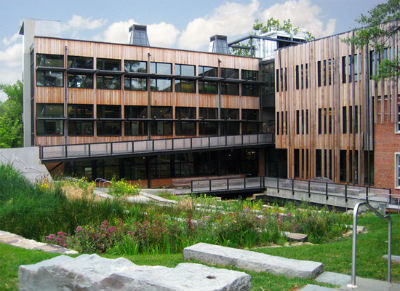NEW BERN – For close to a decade, the N.C. Coastal Federation has actively promoted low-impact development strategies as a method to continue needed economic development while protecting the ecosystems that make people want to live and work along the coast in the first place.
The advocacy has had some notable successes: rain gardens have blossomed at schools and residential subdivisions all along the coast; local governments, such as Wilmington, Brunswick County and Cape Carteret in western Carteret County have approved LID techniques as options to conventional runoff controls; and the state has incorporated LID in its stormwater rules.
Supporter Spotlight
Now the federation can prove to developers that LID saves money or real estate on large commercial projects with a recent study that compared the cost of using a conventional system versus LID at a Harris Teeter shopping center in New Bern.
In a world battered in recent years by economic woes, saving money has become more important than ever to most developers, especially when it comes to complying with regulations. The mostly common sense strategies of LID, says Lauren Kolodij, the federation’s deputy director, when applied at the appropriate time, can save considerable amounts of cold, hard cash.
“We thought that one way to promote the use of LID and gain interest in its implementation would be to demonstrate real cost savings with the approach,” she said, “especially on very valuable commercial real estate.”
 Lauren Kolodij |
Owners or developers of such properties tend to be reluctant to experiment with their or their clients’ money. So Kolodij and others hatched the idea of doing a serious, impartial study of an already planned commercial and permitted project, engaging an engineering firm to “start at the start” and do a cost comparison of how the project would have fared using LID concepts. The federation obtained a $15,000 grant from the state Attorney General’s Office’s Environmental Enhancements Grant Program for the work.
“We assembled a subset of the project team, including the state Division of Energy, Mineral and Land Resources, Swain & Associates real estate developers, Withers & Ravenel engineers and the federation to redesign a large commercial shopping center with LID stormwater techniques,” Kolodij said.
They chose the Harris Teeter shopping center in Carolina Colours in New Bern as their test site. It had been designed and permitted using conventional stormwater controls.
Supporter Spotlight
“The idea was to compare LID and conventional stormwater designs side-by-side. The redesign helps illustrate the environmental and economic benefits of LID over conventional stormwater designs,” said Kolodij.
The study showed that the LID stormwater measures would have cost $200,000 more than the conventional system, but would have required less land. The redesigned project ends up with a little more than two more acres that could then be developed.
Generally, according a report by Withers & Ravenel, the idea was to make use of natural landscaping as much as possible to filter the pollutants from the stormwater, instead of collecting it through drains and pipes and sending it to a large constructed wetland. The LID option proposed a one-acre stormwater wetland on the west side of the site, using the outfall to reduce pipe sizes and lengths for the storm sewer network in the originally permitted plan.
In an effort to further reduce the infrastructure costs, the Harris Teeter building itself was moved 10 feet to the east, making room for a vegetated swale behind a loading dock. That resulted in the elimination of one row of parking, which was regained through parking lot reconfiguration.
And the parking lot, according to the report, was reconfigured to incorporate vegetated stormwater storage areas, including tree boxes with filters and vegetated swales, but without hampering traffic flow. The reconfiguration did require relocation of one outparcel but the net parking total actually increased.
Another key was the conversion of the conventional parking lot to pourous concrete, allowing rain to infiltrate down to a 2-inch thick gravel base and gradually discharged into the drainage system through perforated pipes. If that layer – with a 130,000-gallon capacity – were to fill with water, the system would overflow into catch basins.
The whole system could drain by gravity, or it could be connected to the development’s irrigation system for re-use, reducing the overall water demand on the site.
 The redesign included an artificial wetland to treat stormwater such as the one pictured above at the renovated Sidwell Friends School, the Quaker school of choice for the Obamas, the Clintons, the Gores, the Bidens, the Nixons — practically every member of Washington’s politocracy. Photo: Andropogon Associates |
The addition of the vegetated stormwater storage areas requires a smaller artificial wetlands the report states, and “the addition of integrated stormwater controls within the site results in a more efficient land use on the parcel as a whole,” allowing for creation of a second outparcel.
In summary, the report states, “The proposed LID elements combined to provide a total of 72,755 cubic feet of water quality storage,” and meet the state’s requirement for retention of a 1-inch rainfall.
The report also notes that another option – a green roof – that was not incorporated, could have been, and that would reduce energy use in the grocery store building and eliminate roof runoff, saving an additional 23,000 square feet of allowable impervious surface or a further reduction in the size of the constructed wetlands.
Withers & Ravenel also noted that even more LID functionality could have been achieved if the soil on the site had been sandier, because the permeable paving-and-drainage system would have been even more effective, reducing flow to the wetlands by more than 90 percent. That improved infiltration, combined with even more use of the vegetated swales could have totally eliminated the need for the downstream constructed wetlands.
In conclusion, the report states that a large percentage of the land in coastal North Carolina would be even more amenable to dramatic reductions in infrastructure costs through LID strategies.
And the all-important bottom line?
Excluding the green roof, which is not required to meet stormwater regulations, construction costs were estimated to increase from $2 million to $2.2 million for the LID aspects of the design, which is a 10 percent increase.
“Compare that to the 16.7 percent increase in buildable area,” the report states. “This shows that though slightly more expensive, the value gained … exceeds the cost.”
Kolodij stressed that all this was possible even with the challenges imposed by the poorly-drained soils at this site. She also noted that project’s basic layout was already determined before alternative stormwater designs were considered. LID works best, she said, when it’s included in a projects earliest planning stages.
The study shows that LID can be done anywhere, even when soil types are a limiting factor, Kolodij said.
“Better soils and the opportunity to design the shopping center from the outset using a LID design would result in significant cost-savings in building a stormwater management system,” the report concluded. “Therefore, this case study helps to demonstrate that LID stormwater management systems are economically viable for commercial development projects in eastern N.C. Given that such systems have been shown to provide better water quality protection, this case study indicates that LID is a prudent affordable strategy to protect coastal water quality for fishing, shellfishing and swimming in eastern N.C.”
The federation, Kolodij said, plans to use the study as often as possible in discussions with developers.
“For example, we recently worked with Gray Engineering Consultants Inc. and the vice president and senior real estate manager of Paramount Development Corp out of Myrtle Beach to discuss the possibility of incorporating LID design into a newly proposed Wal-Mart in southeastern coastal North Carolina,” she said. “Based in part on the presentation about Carolina Colours, the developers are pursing infiltration in the parking areas of the new Wal-Mart.”
Withers & Ravenel presented the project at the 2013 international LID conference that was attended by over 800 participants and held in St. Paul, Minn.








